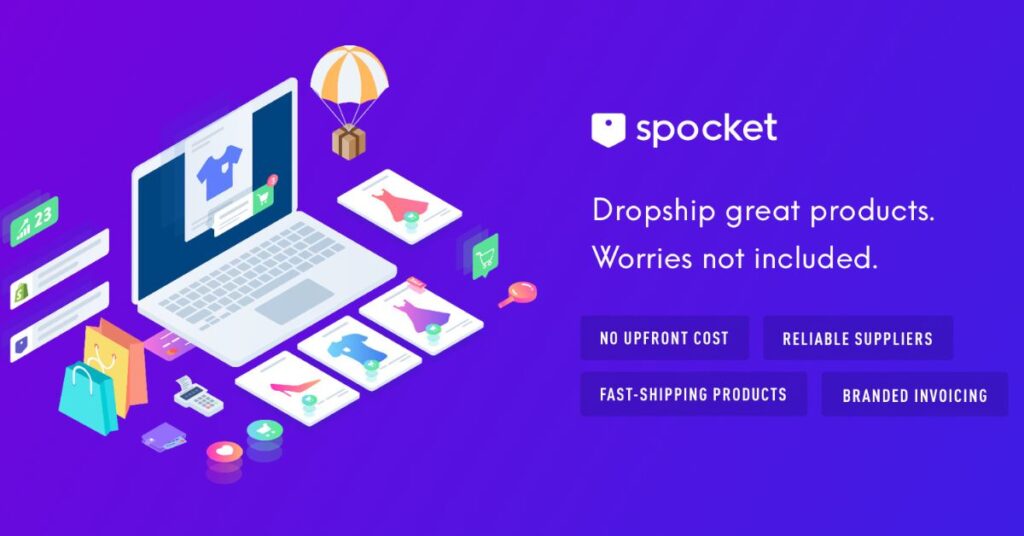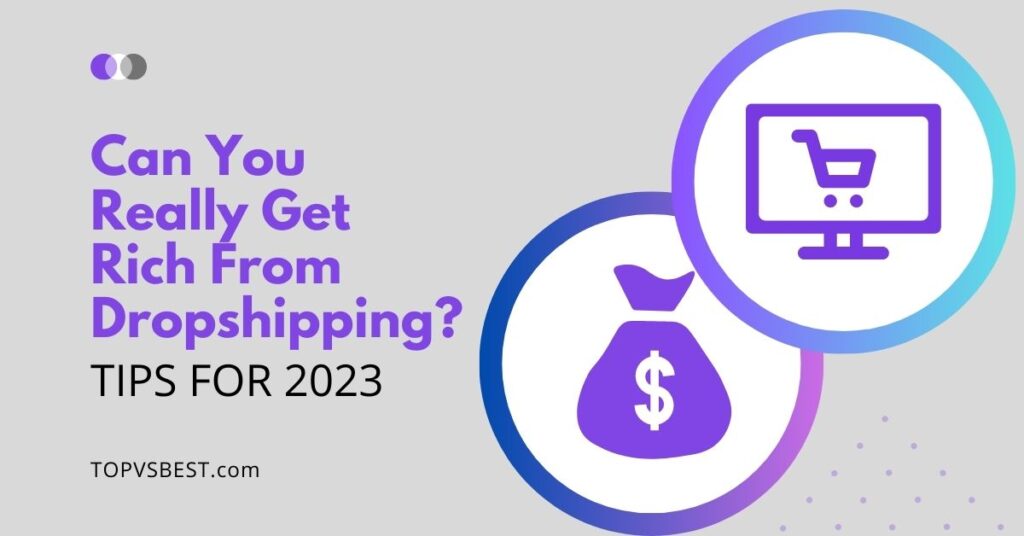Overview
In the dynamic world of e-commerce, dropshipping has emerged as a buzzword, capturing the imagination of aspiring entrepreneurs seeking financial success.
With promises of low startup costs, minimal inventory management, and the allure of creating a thriving online business, it’s no wonder that many are drawn to the prospect of dropshipping.
But amidst the hype and excitement, a fundamental question lingers: Can you really get rich from dropshipping?
In this comprehensive guide, we’ll dive into the intricacies of dropshipping, debunk myths, and offer practical insights into the income potential of this business model.
Whether you’re a novice exploring the possibilities or a seasoned entrepreneur seeking to refine your strategy, these tips for 2023 will provide you with a balanced perspective on the road to dropshipping prosperity.
What Is Dropshipping?
Dropshipping is an e-commerce fulfillment method where a retailer does not keep products in stock. Instead, when a customer places an order, the retailer purchases the item from a third-party supplier, who then ships the product directly to the customer.
This model eliminates the need for the retailer to manage inventory or handle shipping logistics.
Pros Of Dropshipping:
Cons Of Dropshipping:
How Does Dropshipping Work?
In dropshipping, the retailer’s role primarily revolves around marketing, customer service, and managing the online storefront.
While it offers advantages in terms of reduced financial risk and operational complexity, it also presents challenges that require careful consideration and strategy.
The effectiveness of dropshipping hinges on selecting reliable suppliers, offering competitive pricing, and delivering excellent customer experiences.
It’s an approach that requires meticulous planning and execution to strike the right balance between convenience and profitability.
While the allure of becoming an overnight millionaire in the dropshipping world is often overstated, the potential for sustainable earnings is undeniably present
How To Start Dropshipping
Many new entrepreneurs start their businesses on Shopify because starting dropshipping on Shopify is incredibly convenient.
Shopify provides user-friendly tools to set up your online store, list products, and manage orders easily. Its all-in-one platform offers various templates, making it simple to create a professional-looking website even if you’re new to e-commerce.
On the other hand, WooCommerce, often used with hosting platforms like Bluehost, Siteground, or Hostinger, is a cost-effective option.
It’s a WordPress plugin allowing you to add an online store to your existing website. While it requires a bit more setup, it’s a budget-friendly way to start dropshipping if you want to minimize initial expenses.

Here is how to start Dropshipping in 7 easy steps:
- Pick a Product to Sell: Choose something people want to buy and that you’re interested in selling.
- Check If It’s a Good Idea: Look at what’s popular and see if others are selling similar things. Make sure there’s a demand.
- Find Someone to Supply the Product: Connect with reliable suppliers (Spocket, Zendrop, or CJDropshipping) who can provide you with the product you want to sell.
- Create a Website: You can build a website to showcase your product using platforms like Shopify, WooCommerce, or even Etsy and Amazon. (Shopify often has free trials or affordable options.)
- Tell People About Your Product: Use social media, ads, or other methods to let people know about your product. As you grow, you can fine-tune your strategies to reach more people.
- Make Customers Happy: Treat your customers well and make sure they’re satisfied. This will keep them coming back and recommending your products to others.
- Keep Things Legal and Organized: Stay on top of taxes and other legal stuff. It’s important to keep everything in order for a smooth-running business.
By following these steps, you can start dropshipping without breaking the bank. Platforms like Shopify, WooCommerce, and Amazon offer tools to help you get started and build a successful business over time.
Follow the link to read how to create an online store with Shopify.
How To Start Dropshipping On Amazon
When engaging in Amazon dropshipping, several policies necessitate attention. Amazon does indeed permit dropshipping, albeit under stringent regulations that sellers are obligated to adhere to.
For instance, sellers must assume the role of the designated seller for the product, assuming accountability for customer service and returns. Furthermore, utilizing another retailer or marketplace to fulfill orders is prohibited.
Success in Amazon dropshipping, including through Amazon FBA, hinges on meticulous policy adherence and strategic considerations such as proficient product branding.

To initiate dropshipping on Amazon, follow these steps:
- Research and Niche Identification: Conduct thorough market research to identify potential niches with demand and manageable competition.
- Supplier and Product Selection: Carefully evaluate suppliers for reliability, quality, and shipping capabilities. Choose products that align with your chosen niche and have a competitive edge.
- Amazon Seller Account Setup: Register for a seller account on Amazon. Provide accurate business information and bank details for transactions.
- Product Listing and Optimization: Create compelling product listings with clear titles, detailed descriptions, and high-quality images. Optimize listings using relevant keywords to enhance visibility.
- Order Management and Customer Service: Monitor incoming orders regularly and ensure seamless order processing. Address customer inquiries promptly and professionally to maintain positive reviews.
Read our Dropshipping On Amazon: Best Guide For 2023 And Beyond for a detailed breakdown of dropshipping on Amazon.
How To Start Dropshipping For Free On Amazon
You can start dropshipping on Amazon for free using the Individual Plan, which has no registration costs. With this plan, you pay $0.99 per item sold, which allows you to list your products.
However, keep in mind that there are other costs to consider, like Fulfillment by Amazon (FBA) fees, which can be around 15% of the item’s price, and Amazon’s referral fees, which vary by category.
While the Individual Plan provides a low-cost entry, be aware of these additional expenses that can impact your overall profitability.
How To Start A Dropshipping Business With No Money
If you’re launching a dropshipping venture with limited capital, consider these strategies:
- Utilize Free Trials and Platforms: Leverage platforms that offer free trials to set up your store without initial costs. Experiment with different platforms to identify the best fit.
- Social Media Marketing: Harness the power of social media platforms to promote your products and reach a wider audience without significant advertising costs.
- Gradual Reinvestment: As your business gains traction, reinvest your earnings into scaling operations. Gradually expanding your product range and marketing efforts can lead to sustained growth.
By following these steps and strategies, you can establish a strong foundation for your dropshipping business on Amazon or elsewhere, even if you have limited financial resources.
Success in dropshipping hinges on careful planning, continuous adaptation, and a commitment to meeting customer expectations
By adopting these methods, even entrepreneurs with limited financial reserves can forge a resilient foundation for their dropshipping enterprise.
Read our guide: How to Start Dropshipping for FREE for more budget tips.
Is Dropshipping Legal?
Yes, absolutely, it is legal! But addressing the legal aspects of dropshipping is crucial for maintaining a compliant and reputable business:
- Legal Validity: Engage in due diligence to ensure that your dropshipping activities align with legal regulations and norms within your jurisdiction.
- Supplier Agreements: Establish transparent agreements with suppliers to delineate responsibilities, pricing, shipping, and product quality. These agreements foster clarity and avert potential disputes.
- Intellectual Property: Abstain from infringing on intellectual property rights when using product images, descriptions, and branding. Obtain proper licenses or permissions when necessary.
- Consumer Protection: Comply with consumer protection laws by providing accurate product descriptions, transparent pricing, clear refund policies, and responsive customer support.
- Taxes and Licensing: Understand and fulfill tax obligations applicable to your business, including sales tax, income tax, and any necessary licenses or permits.
- Data Privacy: Safeguard customer data and adhere to data protection regulations by implementing proper security measures and obtaining consent for data usage.
- Communication: Maintain transparent communication with customers about shipping times, product quality, and potential delays. Honesty fosters trust and minimizes legal risks.
Understanding legal issues in dropshipping can shield your business from legal entanglements, bolster its credibility, and cultivate enduring customer relationships built on transparency and integrity.
So Can You Really Get Rich From Dropshipping?
Evaluating The Profit Potential
Discerning the profit potential in dropshipping demands a comprehensive assessment of several key facets:
- Niche Selection: The profitability of your chosen niche hinges on demand, competition, and consumer willingness to pay. Conduct thorough market research to find viable niches with promising returns.
- Marketing Strategies: The effectiveness of your marketing initiatives will significantly influence your profit potential. Employ diverse strategies, such as social media marketing, influencer collaborations, and search engine optimization (SEO), to elevate product visibility.
- Product Pricing: Striking an optimal balance between competitive pricing and preserving profit margins is vital. Thoroughly analyze your costs, competition, and market trends to determine appropriate pricing.
- Profit Margins: Acknowledge that dropshipping profit margins can be relatively modest due to intermediary costs. Effective cost management and efficient operations are central to sustaining profits.
- Customer Acquisition Costs: Gauge the expenses incurred in acquiring each customer through marketing efforts. Ensuring that customer acquisition costs align with your profit margins is important.
- Scaling Strategies: Consider the scalability of your operations. As your business grows, identify methods to increase efficiency, negotiate better supplier terms, and explore avenues for expansion.
- Adaptability: The e-commerce landscape is dynamic. The profit potential is maximized by staying attuned to market shifts, customer preferences, and emerging trends.
- Risk Management: Understand that profit potential is intertwined with potential risks. Analyze factors like market volatility, supplier reliability, and customer satisfaction to mitigate risks that could impact profitability.
A holistic evaluation of these components empowers dropshippers to gauge the profit potential realistically and strategically. By carefully assessing these factors, you can forge an informed path toward optimizing profits within the dynamic realm of dropshipping.
Realistic Expectations
Embracing realism when it comes to dropshipping is useful, dispelling the temptation of immediate wealth:
- Gradual Growth: Expect incremental growth in your dropshipping venture rather than swift prosperity. Sustainable success often unfolds over time as you refine strategies and build a solid customer base.
- Initial Challenges: Understand that the onset may be marked by challenges such as customer acquisition, supplier coordination, and market competition. Diligence in navigating these obstacles is essential.
- Profit Margin Dynamics: Recognize that profit margins in dropshipping might not mirror those of traditional retail. While they can be narrower, prudent cost management can contribute to viable profitability.
- Marketing Commitment: Effective marketing is a cornerstone of success. Understand that consistent, strategic marketing efforts are crucial for brand visibility and customer engagement.
- Learning Curve: Expect a learning curve in understanding market dynamics, customer preferences, and effective operational tactics. This learning process is integral to refining your approach.
- Adaptability: Agility in adapting to changing market trends and customer expectations is vital. A willingness to evolve your strategies based on data-driven insights is key.
- Consistency and Persistence: While rapid riches are often depicted on Youtube and elsewhere, persistence and consistent effort yield enduring success. A steadfast commitment to refining your approach contributes to sustainable growth.
Dropshippers must approach their endeavors with the patience, dedication, and adaptability necessary to navigate the evolving e-commerce landscape by dispelling unrealistic notions and embracing a pragmatic outlook.
Success Rates And Earnings
Exploring the success rates and earnings within the dropshipping sphere can provide a better understanding:
- Success Metrics: Success rates among dropshippers can vary significantly. Factors such as niche selection, marketing strategies, and operational efficiency greatly influence the likelihood of success.
- Success Rate Statistics: Precise success rates are elusive due to the diverse nature of dropshipping ventures. However, it’s acknowledged that many dropshippers face challenges and may not attain sustainable success.
- Earnings Variation: Earnings in dropshipping span a wide spectrum. Some achieve moderate profits, while others experience more substantial financial gains. Individual results depend on several variables, including effective strategies and market conditions.
- Average Income: Determining the average income of dropshippers can be complex due to the broad range of factors at play. It’s crucial to avoid overestimating potential earnings and instead focus on an informed strategy.
- Successful Dropshippers: Successful dropshippers are typically those who have cultivated a deep understanding of their niche and market demand, employed innovative marketing approaches, maintained quality customer service, and efficiently managed their operations.
- Sustainable Earnings: Sustainability in earnings necessitates consistent effort, continuous adaptation, and prudent financial management. While instant riches are uncommon, the potential for long-term profitability is attainable with the right approach.
- Annual Earnings: Annual earnings of successful dropshippers vary widely, with some achieving modest supplementary income and others generating substantial revenue in millions of dollars. It’s essential to set realistic goals and continually optimize strategies for growth.
By grasping the diversity in success rates and earnings, you can make informed decisions, set achievable goals, and cultivate strategies that position them for long-term prosperity within the dynamic landscape of e-commerce.
Frequently Asked Questions
Absolutely, dropshipping will remain a lucrative venture in 2023. Successful dropshippers can generate impressive profits, with some earning up to $100,000 annually and much more. However, success depends on factors like niche selection, marketing strategies, and operational efficiency.
Approximately 10% of dropshippers find success. While not universal, this percentage showcases that with effective strategies, commitment, and adaptability, dropshipping can indeed lead to favorable outcomes in the e-commerce world.
The average dropshipper can earn around $10,000 to $50,000 annually. This range reflects the diversity in niches, product selection, and marketing efforts. Diligence in strategy execution can contribute to maximizing earnings.
Dropshippers typically make between $0 to $5000 per week. However, this figure can vary based on the products offered, pricing strategy, and effectiveness of marketing campaigns.
A successful dropshipper can earn a comfortable annual income of $50,000 to $1,000,000. Strategic niche selection targeted marketing, and efficient operations contribute to achieving this level of success.
Absolutely! While it may not be the standard outcome, dropshippers have indeed achieved millionaire status. With meticulous planning, dedicated execution, and the right combination of factors, dropshipping can certainly pave the way for substantial financial success.
Conclusion
As the digital landscape continues to evolve, dropshipping remains an intriguing avenue for those seeking financial independence through e-commerce.
Our journey through the intricacies of dropshipping has revealed a nuanced reality—one where success isn’t guaranteed, but it’s certainly attainable with the right approach.
While the allure of becoming an overnight millionaire in the dropshipping world is often overstated, the potential for sustainable earnings is undeniably present.
By combining a thorough understanding of the dropshipping model, diligent research, relentless effort, and a dose of patience, you can navigate the challenges and seize the opportunities that come your way.
Remember, dropshipping isn’t a magic formula for instant wealth but a strategic endeavor that rewards dedication and adaptability. So, as you embark on your dropshipping journey armed with the insights from this guide, may your efforts be met with success, growth, and a realistic path to achieving your financial aspirations.



